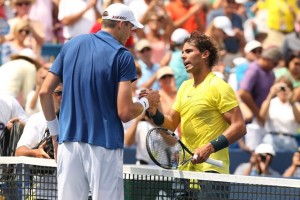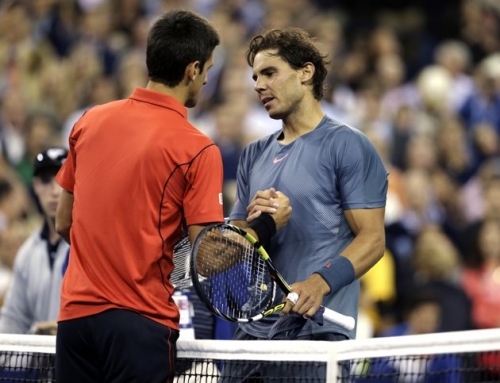 Of the two, John Isner generally has the more straight-forward strategy. He knows his liabilities: he doesn’t return particularly well, and he doesn’t run particularly fast. These two constraints dictate his style of play. Hit big serves, hope for weak returns, and go for big shots on the forehand. On the return of serve, take chances on second serve returns, running around the backhand to hit forehands. This strategy seemed particularly useful since Nadal’s serving strategy, particularly second serves, often is pretty simple-minded. Spin it to the righty’s backhand.
Of the two, John Isner generally has the more straight-forward strategy. He knows his liabilities: he doesn’t return particularly well, and he doesn’t run particularly fast. These two constraints dictate his style of play. Hit big serves, hope for weak returns, and go for big shots on the forehand. On the return of serve, take chances on second serve returns, running around the backhand to hit forehands. This strategy seemed particularly useful since Nadal’s serving strategy, particularly second serves, often is pretty simple-minded. Spin it to the righty’s backhand.
For Nadal’s part, his goal was to use his superior groundstroking to hold his own serve, and realize that a player like Isner is going to take chances, thus produce more errors. In a way, because Nadal is so effective off the ground, he makes his opponents play more aggressive, and thus more error-prone, thus, increasing his chances of holding serve.
In an interview after Federer beat Tommy Haas, Federer was asked if Nadal was playing noticeably different the past few weeks. Federer said not really. Rafa plays Fed very aggressive as he has been doing. The only difference is, against other players, Rafa sometimes plays more passively. Thus, he is playing more aggressively against players not named Federer too.
The reason for this change of strategy is fairly obvious.
Rafa’s knees.
Rafa’s never-say-die attitude plus his innate hatred of giving up or producing too many errors has meant Rafa chases down more shots than most players. And because he doesn’t like errors, he’s sometimes played more cautiously, drawing out rallies much longer, and pressuring himself to run down impossible shots.
This has come at a price, namely, numerous occasions where Rafa has had to leave the tour, most notably, last year’s 7 month excursion after Wimbledon.
Now, Rafa’s always had the ability to play aggressive. He can hit hard. He can play like countryman, Verdasco, but it doesn’t come particularly naturally for him. He’s often been too patient waiting for the right shot to attack.
In the past few weeks, Rafa’s goal has been to hit harder, even at the cost of increased unforced errors. He’s quicker to take shots to the sidelines, knowing that his accuracy is still quite good (he often hit such shots under duress, rather than as a first choice).
Rafa did make a few unusual choices in the match against Isner. In particular, early on, he hit a few slow high loopers. Now Isner is perhaps the second tallest player on tour, just behind Ivo Karlovic. So you would think Nadal’s loopers would have less effect, but Nadal can loop up pretty high, even high for Isner’s strike zone, and since almost no one does that to Isner, it probably threw Isner off a little. I think he was hoping to goad Isner to hitting the ball short so he could attack.
In Montreal, Rafa had decided to return Raonic’s serve by standing very close, hoping to take away the angle, but against Isner, he chose to stand way back, particularly on second serve, where Isner can kick the ball above his opponent’s shoulders. Indeed, against Rafa, big servers often did better on second serves than first serves, but never seemed to catch on, in terms of using the second serve as a first serve.
Rafa’s main playing pattern is to look for a middle ball. He can take pretty much any shot up the middle, and typically hit it hard inside in to a righty’s backhand. He likes to punish this side several times, and wait for a weak enough reply that he then sends it inside out, usually for a winner. The key to play Rafa is to avoid hitting these shots up the middle where Rafa can take the shot to either sideline. Rafa himself manages to avoid hitting these middle shots even though few other players seem to take advantage of hitting middle shots like Rafa does.
As pointed out by commentators, the key to staying in rallies is to find Rafa’s backhand early. Rafa has a solid backhand, bit he plays a lot less aggressively on the side, taking fewer chances, than, say, Djokovic. Despite the differences between Rafa and Federer, he has taken the “running around the backhand” to a further extreme than Federer despite having a backhand that is more solid under pressure than Federer. It’s become nearly impossible to hit to Rafa’s backhand with a slice as Rafa uses the extra time a slice takes to move across the court to take a few extra steps to hit a forehand. Despite having to move backwards to do so, he often hits a very effective inside out forehand, and occasionally, the inside in forehand.
John Isner, for his part, looked a lot better today than at the start of the hardcourt season where his shot-making was not as crisp. At the start of the summer, I would have been dubious of Isner’s ability to make a deep run, but after his string of victories, I think it’s not unreasonable to think this. The big hurdle for Isner is how much tennis he’s played, which is a lot.
Isner made it to the semis of Newport, then there was a week off where play went to Bogota (a hardcourt event), then Isner won Atlanta, was runner-up in DC, then lost early in Montreal, and made the finals of Cincy. He is scheduled to play Winston-Salem which is close to where he grew up in Greensboro. Whether he’ll actually play will be of interest, given that it’s the last event prior to the US Open.
Isner has taken his style of play, which is as much mental, as anything, to its limits. One reason he fares better than Sam Querrey, other than having a better serve that creates fewer returns, is that he is mentally tough during critical points. In particular, he knows he’s likely to play a lot of tiebreaks, that despite working on his return of serve, that he’s unlikely to break, and thus he needs to hold serve. He also knows his opponents, for the most part, struggle to return his serve, and so he will face very few break points, but even when he does, Isner manages to serve well.
Of course, there are players that have firepower on their first serves, like Samuel Groth or like Chris Guccione (seems like Aussies do a good job of producing such power servers), but nonetheless are mired down in the rankings because they don’t have enough of the rest of their games to matter. For Isner, he relies on his huge forehand to take big swipes at the ball and finish points early so he doesn’t get caught way behind the baseline, retrieving shots (which is one way he handles being slow), and it’s his forehand that keeps him relevant in men’s tennis. Without his ability to take over a point, opponents would return enough shots that Isner would get broken more often.
In a way, much like Isner, Rafa must have felt that, in a tiebreak, he would have his chances to win. Rafa tends to hold serve pretty easily because he’s superior off the ground. Unless Isner happens to return a second serve well, Rafa has the advantage. Rafa helped his cause by serving to the forehand on big points against Isner, thus neutralizing his attempts to move left and hit a big forehand. Isner was left guessing wrong a few times when Rafa changed things up, and it came at key points for Rafa.
Not that Isner can really push Rafa around, but because both Rafa and Isner were aggressive, the rallies were kept pretty short. I don’t think any rally lasted 20 shots, and often didn’t last 10 shots. Rafa did look a touch fatigued, but it didn’t seem to matter that much since the rallies weren’t too lengthy.
Expect Rafa to maintain this aggressive style of play throughout the US Open. He’ll probably want to figure out how to shave a few unforced errors off his game, but so far, he’s playing solid tennis. It’s now on Djokovic and Murray to figure out how to beat Rafa.
Isner, meanwhile, needs to keep fresh. His confidence level is high. He just wants to avoid playing a guy that can return a big serve (say, Federer) and make him work on serves knowing his chances to break are tough.
Keep in mind that how a player plays leading up to a Slam may not be the same as how they play at the Slam. Last year, Federer won Cincy, but Murray lost early at both Toronto and Cincy. Nonetheless, Federer lost in the quarterfinals of the US Open while Murray won it.



![[Paris] Djokovic finishes post US Open tournaments undefeated with win over Ferrer](https://www.essentialtennis.com/wp-content/uploads/2013/11/20131103nole-500x383.jpg)
![[Shanghai] Djokovic wins the China double, adding Shanghai title to Beijing](https://www.essentialtennis.com/wp-content/uploads/2013/10/20131013nole-500x383.jpg)
![[Shanghai, SF] del Potro upsets Nadal in awesome display of power](https://www.essentialtennis.com/wp-content/uploads/2013/10/20131012delpo-500x383.jpg)

![[US Open Men’s Final] Can Djokovic beat Nadal in the finals?](https://www.essentialtennis.com/wp-content/uploads/2013/09/20130909djokovic-500x383.jpg)